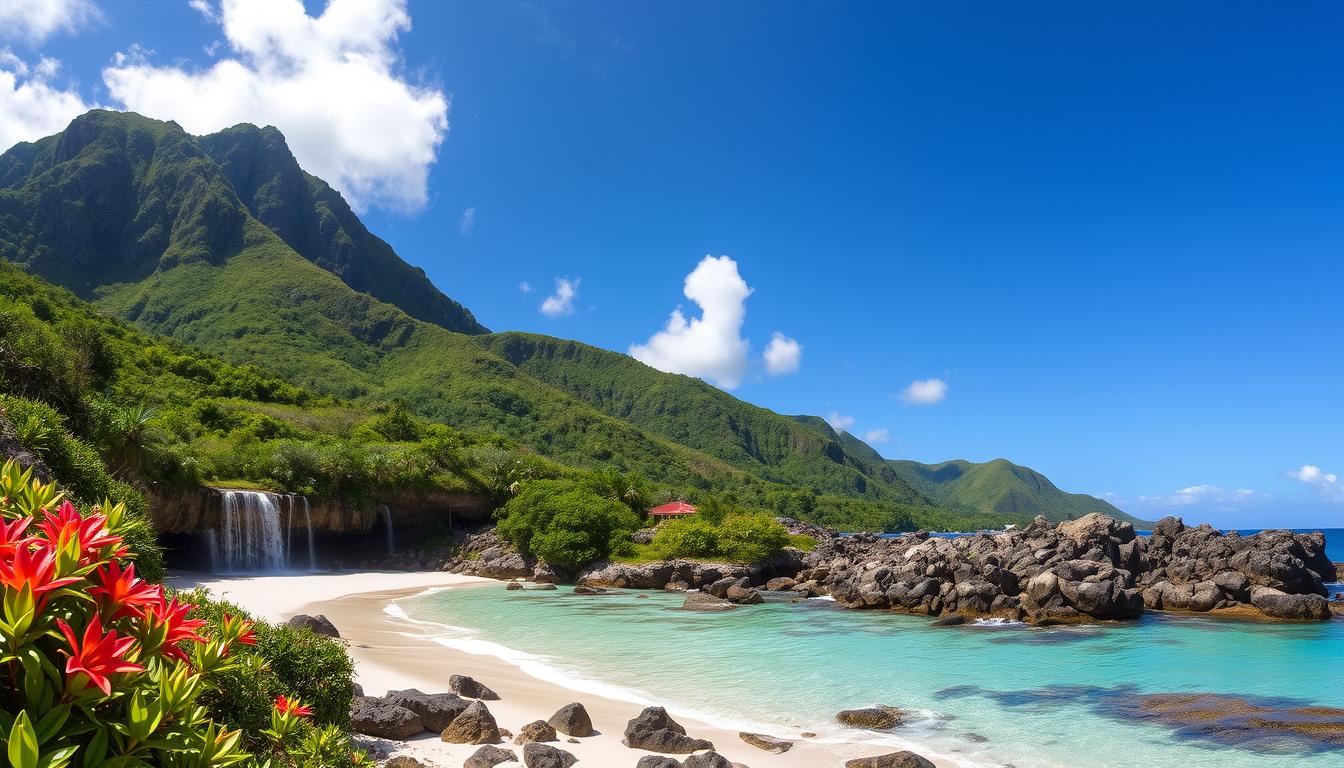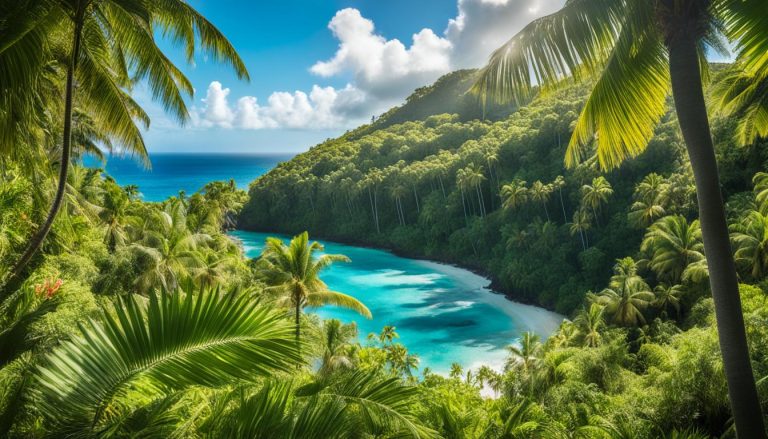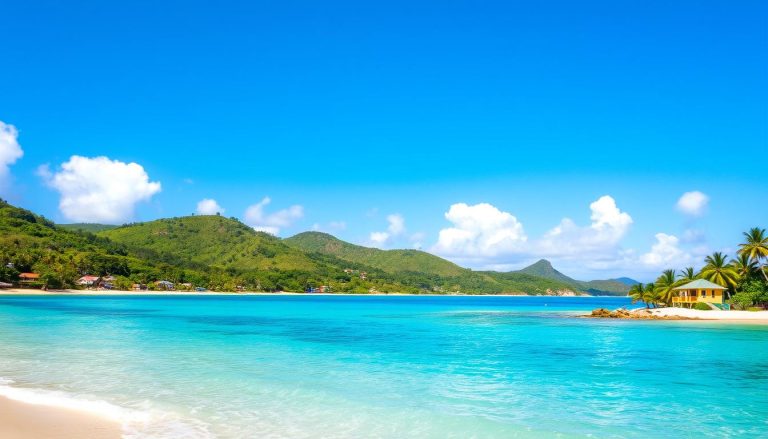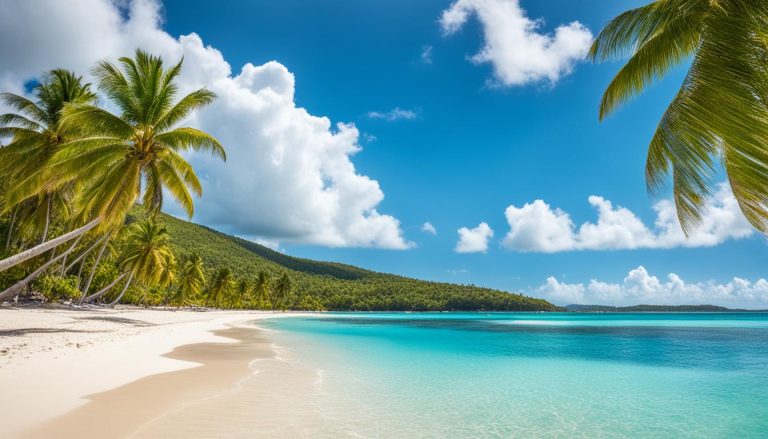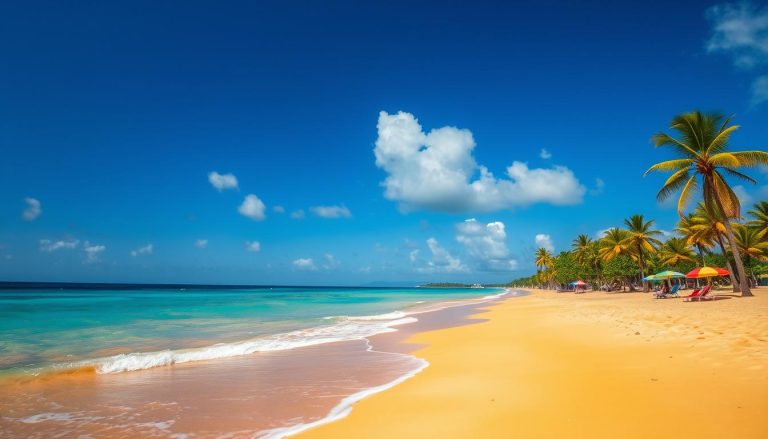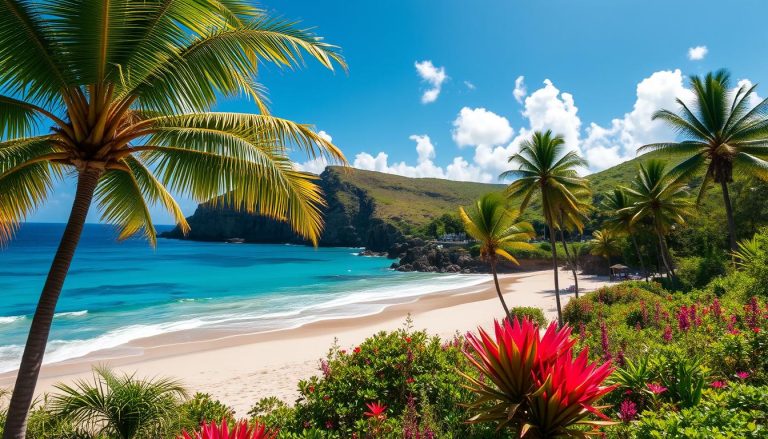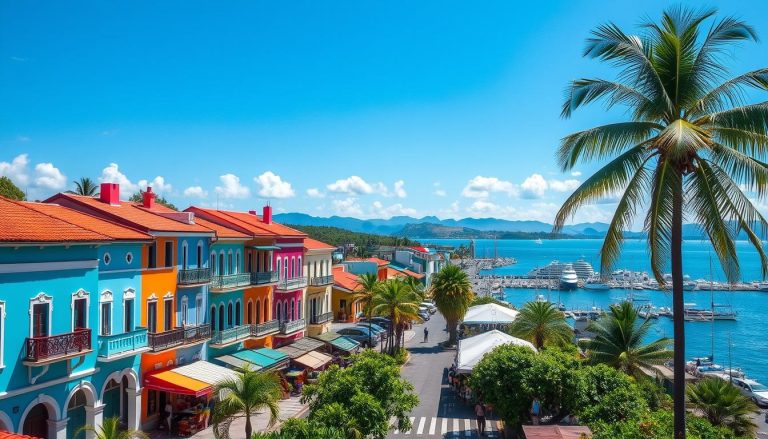Ever dreamed of a tropical paradise with stunning natural wonders and rich culture? Welcome to Basse-Terre, Guadeloupe’s western wing. It’s a place of lush rainforests, towering volcanoes, and beautiful beaches. These offer a wilder adventure than Grande-Terre.
Basse-Terre is a nature lover’s dream. It’s home to the Guadeloupe National Park and the Cousteau Marine Reserve. You can hike up the active La Soufrière volcano or see the Carbet Falls. It’s a true Caribbean treasure.
Key Takeaways
- Basse-Terre offers a wilder, more adventurous experience compared to the eastern island of Grande-Terre.
- The island is home to the Guadeloupe National Park, a UNESCO Biosphere Reserve, and the Cousteau Marine Reserve.
- Outdoor enthusiasts can hike to the summit of the active La Soufrière volcano and explore the Carbet Falls in the lush rainforest.
- Basse-Terre boasts stunning beaches that are less impacted by sargassum seaweed compared to the east-facing beaches.
- The island’s diverse landscape provides a range of activities, from hiking and waterfall exploration to snorkeling and cultural experiences.
Discovering Basse-Terre: An Introduction to Guadeloupe's Wild Side
Basse-Terre, the larger island of Guadeloupe, is a captivating spot. It shows the island’s wild beauty. Located on the western Caribbean, Basse-Terre has many attractions for those who love adventure.
Geographic Location and Features
Basse-Terre is known for its rugged mountains and the famous La Soufrière volcano. It’s the highest point in the Guadeloupe National Park at 1,467 meters. The island’s interior is a lush rainforest, full of plants and animals, perfect for nature lovers.
Climate and Best Time to Visit
Basse-Terre has a tropical climate. It’s dry from December to May and rainy from June to November. The best time to visit is during the dry season. The weather is sunny, and the temperatures are just right for exploring the Basse-Terre attractions and the National Park of Guadeloupe.
Cultural Heritage Overview
Basse-Terre’s culture is a mix of French, African, and Caribbean traditions. The capital, Basse-Terre City, shows the island’s history. Landmarks like Fort Delgrès highlight the island’s past.
“Basse-Terre is a true gem in the crown of Guadeloupe, offering a unique and captivating experience for those seeking to immerse themselves in the island’s natural wonders and cultural heritage.”
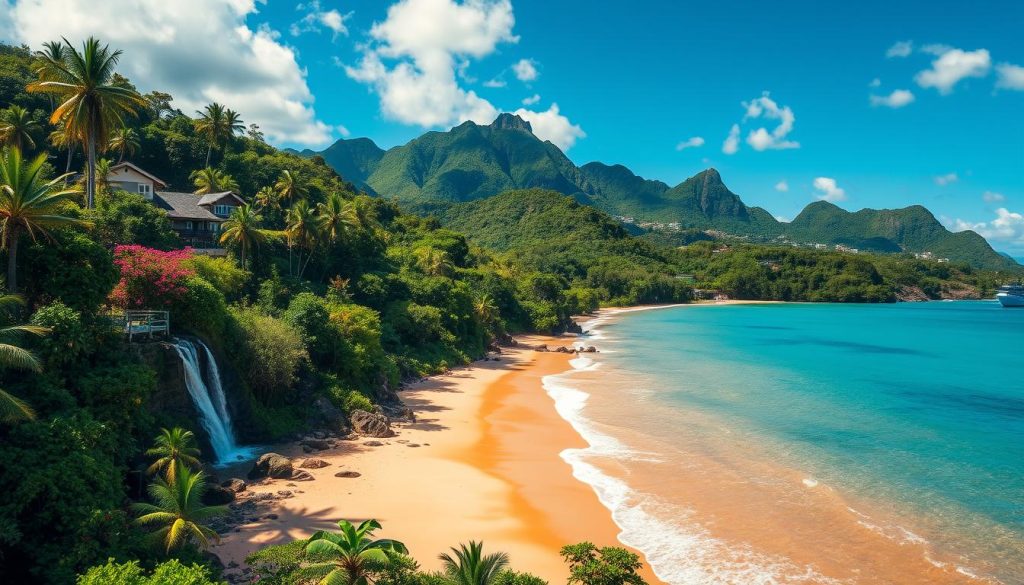
How to Get to Basse-Terre and Transportation Options
Getting to Basse-Terre, the lush island of Guadeloupe, is easy. Most people fly into Pointe-à-Pitre International Airport on Grande-Terre. Then, they cross the narrow strait to Basse-Terre. Guadeloupe tourism and Caribbean travel fans have a few ways to get around.
The Karu’lis bus system is available for public transport. But, it runs less often. Renting a car is better for seeing Basse-Terre’s sights. Car rentals might seem cheap, but watch out for mechanical issues and billing problems.
Ferry rides from Trois-Rivières to nearby islands are another option. They let you visit places like Terre-de-Haut in the Les Saintes archipelago. This is a great way to see the Caribbean travel area’s beauty.
Taxis in Guadeloupe can charge more at night. A ride from the airport to Gosier hotels costs about 30€. Going to Pointe-à-Pitre costs 20€. A day of sightseeing by taxi costs around 200€ for up to four people.
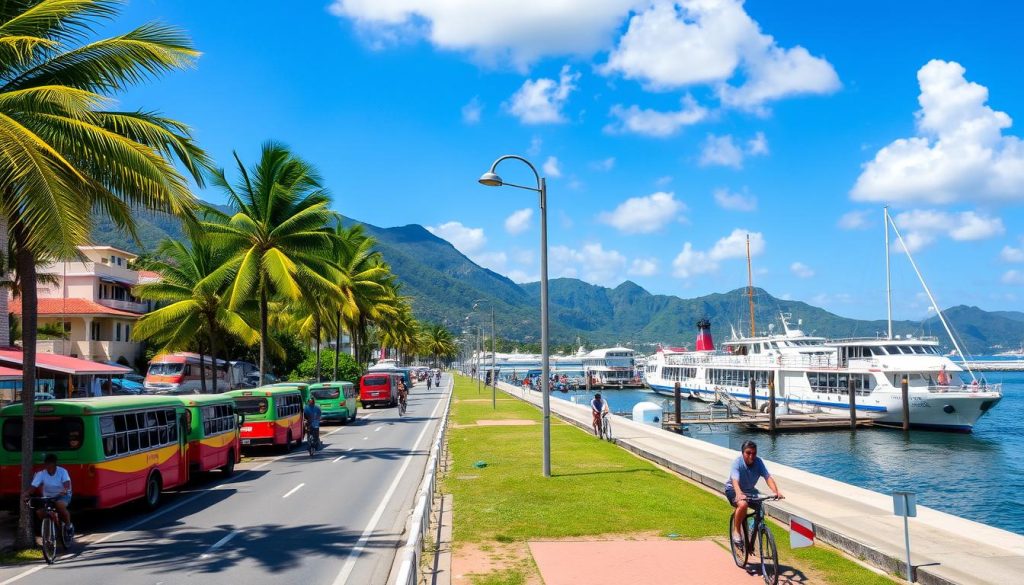
Travelers to Guadeloupe tourism should know costs vary. Daily expenses average $235 USD. This includes where you stay, how you get around, food, and more. With some planning, you can enjoy your Caribbean travel on Basse-Terre.
Natural Wonders of Basse-Terre Island
Basse-Terre Island, the western half of Guadeloupe, is a natural paradise. It boasts the towering Soufriere Volcano, the stunning Carbet Falls, and the vast National Park of Guadeloupe.
Soufriere Volcano Highlights
The Soufriere Volcano stands over 4,000 feet tall, the highest active volcano in the Caribbean. Hikers can tackle a 6-mile round trip to the summit, which takes 4 to 6 hours. At the top, they enjoy stunning views of lush landscapes and the Caribbean Sea.
Carbet Falls Experience
The Carbet Falls cascade down Basse-Terre’s green slopes. The first waterfall drops an impressive 115 meters. Hikers can swim in the cool pools below, after reaching the falls.
National Park of Guadeloupe Exploration
The National Park of Guadeloupe covers over 17,300 hectares. It’s home to diverse flora and fauna, including 300 tree species and 100 orchid varieties. It’s also a haven for bird and mammal lovers, with 38 bird and 17 mammal species.
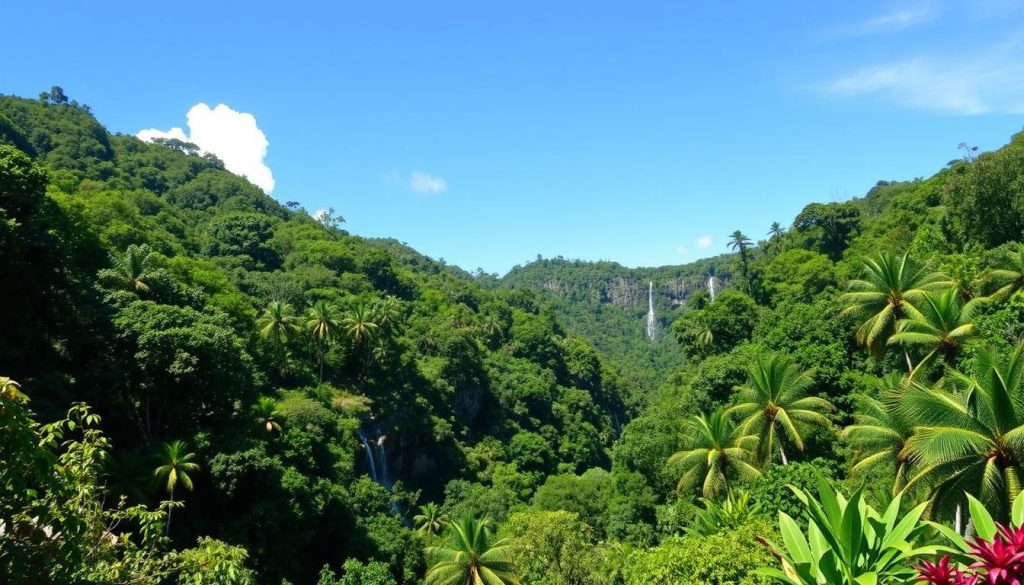
Basse-Terre’s natural wonders offer both thrilling adventures and peaceful escapes. They are sure to make a lasting impression.
Best Beaches in Basse-Terre
Basse-Terre, the rugged western part of Guadeloupe, has stunning beaches. These beaches invite visitors to enjoy the sun and clear waters. From Plage de la Perle’s golden sands to Plage de Malendure’s black volcanic shores, there’s a beach for everyone.
Plage de Petite Anse is famous for its calm waters and great snorkeling. Nearby, Plage de Grande Anse is a hit with surfers. For a quiet spot, try Plage de Pompierre in Terre-de-Haut, where motorboats are banned.
Anse à la Gourde in Saint-François is known for its wild beauty and coral reef. Datcha Beach in Le Gosier is loved for its shallow waters and street food. The longest beach, Plage de Grande Anse in Deshaies, is a must-see for beach lovers.
Malendure Beach in Pointe-Noire is great for water sports and diving, thanks to the Jacques Cousteau Underwater Reserve. Plage de la Perle near Deshaies is a turtle nesting site, perfect for spotting these creatures.
The beaches of Basse-Terre offer relaxation, water sports, and a peek into the island’s wonders. They promise an unforgettable experience in a tropical paradise.
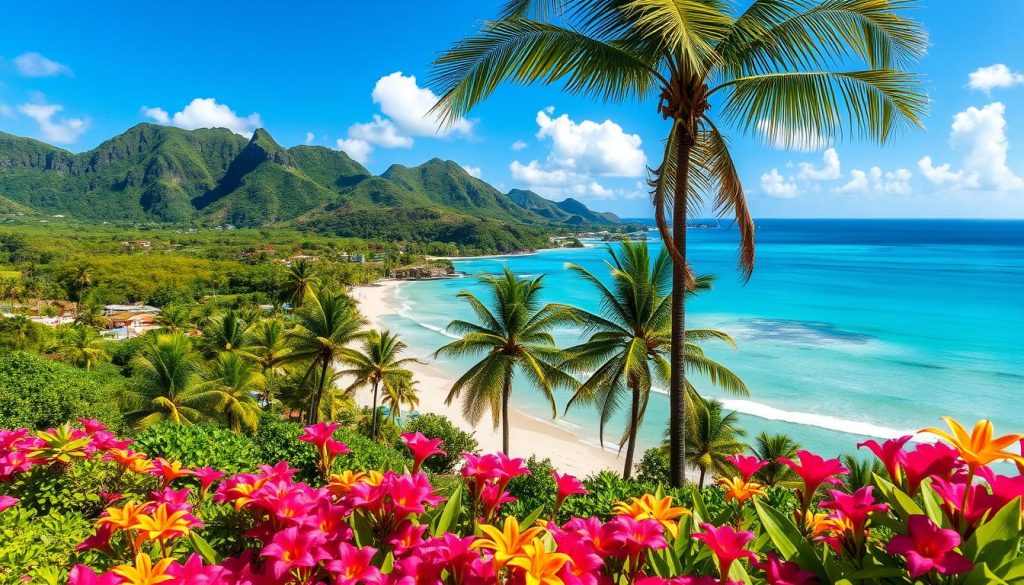
“The beaches of Basse-Terre are a true gem in the Guadeloupe archipelago, offering a diverse array of coastal experiences that cater to every traveler’s taste.” – Jane Doe, travel writer
Basse-Terre Island, Guadeloupe: Best Things to Do - Top Picks
Basse-Terre, the western half of Guadeloupe, is full of activities. It has outdoor adventures and cultural experiences. This part of the Caribbean is exciting for everyone.
Hiking Adventures
Nature lovers will love Basse-Terre Island. There are two hikes you must try. The first is up the La Soufrière volcano, which erupted in 1976. It offers amazing views of the island.
The second hike is to the Carbet Falls. It’s a 45-minute walk through the jungle. You’ll see three beautiful waterfalls in the Guadeloupe National Park.
Water Activities
The western coast of Basse-Terre has beautiful beaches. They are perfect for water activities. You can snorkel or dive at the Jacques Cousteau Underwater Reserve.
Or, kayak through the mangrove forests. Beach-hopping along the west coast is also fun. It lets you enjoy the island’s beauty.
Cultural Experiences
Basse-Terre has a rich history and culture. Visit the 17th-century Fort Delgrès and the 18th-century Cathédrale Notre-Dame de la Guadeloupe. They show French colonial architecture.
Learn about Guadeloupe’s fight for freedom at the Musée Schoelcher. Try traditional Creole food and rhum agricole at the Bologne Rum Distillery.
Basse-Terre Island in Guadeloupe is unforgettable. It has natural wonders, culture, and activities. It’s perfect for adventurous travelers wanting to explore the Caribbean’s wild side.
“Basse-Terre Island in Guadeloupe is a true gem, offering a perfect blend of outdoor adventure, cultural richness, and natural beauty – a must-visit destination for anyone seeking an immersive Caribbean experience.”
Where to Stay: Accommodation Options
Exploring Basse-Terre island in Guadeloupe reveals a variety of places to stay. You can choose from cozy guesthouses to charming boutique hotels. These options offer a more personal and genuine experience than the big resorts on Grande-Terre.
Le Jardin Malanga is a top choice, with its 10 rooms in a 1920s homestead. It offers amazing views of Les Saintes islands. You can also stay near attractions like La Soufrière volcano or by the beach for easy access to the coast.
| Accommodation Type | Recommended Locations | Unique Features |
|---|---|---|
| Boutique Hotels | Deshaies, Pointe-Noire | Intimate atmosphere, stunning views, personalized service |
| Guesthouses | Pointe-Noire, Deshaies | Authentic local experiences, budget-friendly options |
| Beachfront Properties | Sainte-Anne, Basse-Terre | Direct access to pristine beaches, relaxing ambiance |
Basse-Terre has something for everyone, from luxury retreats to affordable stays. It focuses on giving you a real and close experience. This makes your Guadeloupe trip unforgettable.
“The accommodation on Basse-Terre offers a refreshing change from the typical Caribbean resort experience. You can truly immerse yourself in the island’s natural beauty and cultural heritage.”
Local Cuisine and Dining Experiences
Get ready for a culinary adventure in Basse-Terre, Guadeloupe. The island’s food is a mix of fresh seafood, tropical fruits, and spices. It offers a unique and tasty experience.
Traditional Creole Dishes
Try Guadeloupe’s traditional Creole dishes for a taste of comfort. Start with colombo, a curry-like stew with chicken or lamb, coconut milk, and spices. Then, enjoy crispy accras, fritters with codfish or vegetables.
For a real taste of Creole culture, try boudin créole. It’s a savory blood sausage loved by locals.
Best Restaurants and Markets
Basse-Terre has a wide range of food options, from beachside shacks to fancy restaurants. Visit the local markets for fresh produce, herbs, and spices. These are all from the island’s fertile lands.
For a special dining experience, look for restaurants serving nouvelle cuisine Creole. This modern twist on traditional flavors is known worldwide.
Rum Distillery Tours
A trip to Basse-Terre isn’t complete without a rum distillery visit. Head to the Bologne Rum Distillery north of Basse-Terre City. Learn how local sugarcane is turned into smooth, aromatic rums.
“Guadeloupe’s cuisine is a delightful fusion of French and Caribbean flavors, making it a true culinary gem in the Caribbean travel experience.”
Planning Tips and Essential Information
When planning your trip to Basse-Terre Island, Guadeloupe, don’t forget to pack the essentials. You’ll need sturdy hiking shoes, sunscreen, and insect repellent. The dry season, from December to May, is the best time to visit for outdoor fun.
Even though French is the official language, many locals speak Creole too. You’ll use euros in Guadeloupe, so exchange your money before you go. Renting a car is a good idea to explore the island’s roads and find the best things to do – top picks easily.
Always watch the weather, especially if you’re hiking to La Soufrière volcano. Safety is key when exploring nature. With some planning and a sense of adventure, your trip to this Caribbean gem will be unforgettable.
